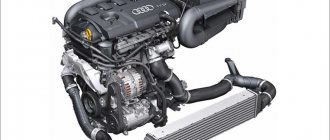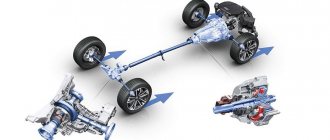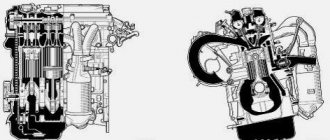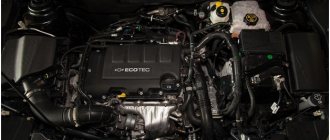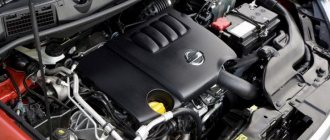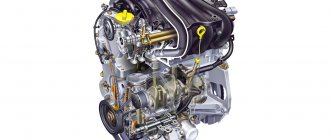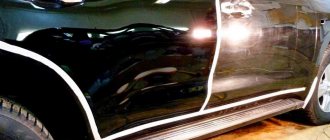The active development of the engineering industry leads to the production of more high-performance cars. Thanks to the implementation of a number of design solutions related to turbocharging, the small-volume engine produces good power. However, this inevitably leads to increased gasoline consumption. Installing HBO on a turbocharged engine is a profitable solution for the car owner. Before contacting a car repair shop, it is advisable to understand the nuances of converting a turbo engine to gas.
What is the difference between a (gasoline) turbocharged engine and a naturally aspirated engine?
The fuel mixture consists of air (oxidizer) and combustible substance. The correct ratio (stoichiometry) of the gasoline mixture is 14.7:1, where 14.7 is the part of air, and 1 is the part of gasoline. Stoichiometric gas combustible mixture (propane-butane) 15.6 to 1, methane 17.2:1.
A supercharged internal combustion engine receives an increased amount of air; therefore, for the normal operation of such an engine, an accurate and fast supply of the required volume of gas is required.
It is possible to achieve the required fuel mixture ratio in an engine with a turbine only by choosing the right equipment.
- HBO injectors should only be high-speed and productive (such as Hana or AEB).
- The gearbox must have a power reserve (the KME brand has proven itself to be excellent).
Also, in order to avoid the negative impact of gas fuel on the engine, it is necessary to pay special attention to the accuracy of setting up gas equipment.
When making adjustments, it is advisable to use a broadband oxygen sensor.
In addition, it is important to remember that 2nd generation LPG is not suitable for a turbocharged engine. It is recommended to install a gas system version 4 or higher.
Is it possible to install LPG (gas equipment) on a turbocharged engine?
The difficult economic trend, accompanied by a steady increase in fuel costs, continues to pose more and more difficult problems for motorists. Vehicle owners continue to persistently try to minimize their considerable vehicle maintenance costs.
Most often they are interested in whether it is possible to install technologically efficient gas-cylinder equipment (LPG) on a turbocharged engine, which is widely used today. On this matter one hears different, sometimes even polar, opinions.
Some drivers claim that this is quite possible and very economically profitable, as it soon begins to provide large savings. Others, on the contrary, are inclined to believe that installing gas equipment in this case is impossible.
Benefits of installing HBO on a turbocharged engine
Many drivers wonder whether it is permissible to install gas on a turbocharged engine. Experts give them a clear positive answer. In recent years, the trend of converting cars to a dual-fuel engine power option, that is, using gasoline or diesel fuel in one case, and a much more profitable fuel option, gas, in another, has become quite stable. More and more motorists in all regions of the country are resorting to it.
There are no fundamental problems with such a translation and should not arise; the whole point is just how to implement this installation. But first, it is worth separately emphasizing all the considerable benefits and advantages that should be expected from such a step. The main ones are the following:
- Installing gas equipment makes it possible to significantly reduce the financial costs of maintaining a car, increase the service life of the engine and other mechanisms.
- Technically, installing LPG on a car, including a turbocharged one, is a simple procedure that takes a few hours.
- After installing an LPG on a turbocharged car, it does not deteriorate its performance characteristics in any way, completely retaining the same principles of operation, its power, and the accuracy of its operation. Only the type of fuel that is used to operate the engine is subject to change.
- Gas is more beneficial than diesel fuel and gasoline from an environmental point of view.
- The service life of lubricants increases.
Features of installing gas equipment on a turbocharged engine
The method of installing gas equipment on a turbocharged engine is not much different from the similar installation of gas equipment on any gasoline car engine.
Such gas systems differ only in a more powerful reducer, thanks to which a normal mixture is ensured in any mode. Here is a list of the main components of gas equipment for a car equipped with a turbocharger.
It is characterized by the presence of a gas cylinder (tank), a mixer, a gas dispenser, a gasoline/gas valve, a special evaporator reducer, pipelines and an electronic system control unit.
Experienced experts strongly advise installing modern gas equipment on cars with a turbocharged engine, recommending, in particular, fourth or fifth generation gas equipment, ideal for such cars. They differ in the methods of fuel injection and control format, namely: the fourth generation gas injection system supplies fuel in the gas version, and the fifth generation gas equipment provides butane injection in the liquid version.
Features of the operation of gas equipment on a turbo engine
The modern generation of gas-cylinder equipment allows the “brains” of the car not to perceive the gas system as something foreign, extraneous, which is due, on the one hand, to the above-mentioned advantages of GBO-5, and on the other, to the characteristics of the fuel itself: the octane number of gas is higher than the corresponding indicator of gasoline, and the controller The equipment takes this into account when injecting fuel into the engine cylinders, automatically adjusting its settings and parameters. In other words, the internal combustion engine power system dynamically adapts to liquefied gas, which allows the power unit to operate smoothly and without interruption.
Installing HBO on a turbocharged engine
The active development of the engineering industry leads to the production of more high-performance cars.
Thanks to the implementation of a number of design solutions related to turbocharging, the small-volume engine produces good power. However, this inevitably leads to increased gasoline consumption.
Installing HBO on a turbocharged engine is a profitable solution for the car owner. Before contacting a car repair shop, it is advisable to understand the nuances of converting a turbo engine to gas.
Which gas equipment for a turbo engine should I choose?
Car owners doubt whether it is possible to install gas equipment on a turbocharged engine? There is a persistent version that this is impossible to do. There is a logical explanation for this. The first inventions of gas-cylinder equipment were designed for cars running on a carburetor. They will not fit turbo engines.
The latest generations of gas equipment have an automatic fuel mixture adjustment system that is capable of maintaining the required injection pressure. Therefore, such an LPG can be installed on a turbo engine without restrictions. When it is decided to install gas on a turbo engine, they choose between the 4th or 5th generations.
The budget version is the 4th generation HBO, where the ECU transmits a signal to the control unit, replacing the commands of standard devices. Such a clever code made it possible to remove many of the negative aspects associated with operating a car on alternative fuel. However, many disadvantages still remain.
Installing HBO on a turbo engine
Thanks to the active development of engine technology, modern engines are becoming more technologically advanced and highly efficient. Moreover, today the displacement of the power unit does not play a key role in determining indicators such as power and torque.
This became possible due to the fact that engineers actively practice boosting the engine, increasing the compression ratio, etc. The installation of high-precision direct fuel injection systems is also widely used, the possibility of dynamically changing valve timing and a number of other design solutions in combination with a turbocharger or compressor are realized.
This approach makes it possible to achieve very impressive characteristics from an internal combustion engine that is initially small in physical volume. However, an increase in power, one way or another, means a simultaneous increase in fuel consumption.
If there were no particular problems with simpler atmospheric engines of previous generations, then with new structurally complex units the question is whether it is possible to install LPG on turbocharged engines. Next, we will look at the features of installing gas equipment on a turbo engine.
Read in this article
How does a turbocharged gas engine work?
As you can see, putting gas on a turbo engine is not a problem. The main thing is that the equipment is correctly selected for the specific type of motor. The fact is that different types of gas installations differ in the implementation of the fuel supply control circuit, and also have some differences in the method of gas injection itself.
The main task of developers of gas-cylinder equipment is the most delicate and functional integration of gas supply in parallel with the standard engine control and power systems.
If we consider the most affordable option, then for a turbo engine this is the 4th generation of gas equipment. In this system, signals from the engine ECU are sent to a separate gas installation control unit and further processed. This is necessary in order to “replace” the commands of the standard “brain”, since the engine is supplied not with liquid gasoline, but with gas.
Further development of the gas supply system in the form of gas equipment of the 5th generation made it possible to completely combine such an installation with standard equipment. The car's ECU does not perceive the gas system as third-party, that is, there are no device conflicts or various errors. Moreover, the gas is supplied to the engine not in evaporated, but in liquefied form.
It should be added that the octane number of gas is higher compared to gasoline. The controller immediately takes such changes into account, automatically adjusting the settings and operating parameters of the internal combustion engine. It turns out that the power system is dynamically adapting to liquefied gas.
This feature allows the turbocharger to operate normally, smoothly, without failures. Installing this system even allows you to start a cold engine on gas rather than gasoline. At the same time, the risks of causing damage to the internal combustion engine and reducing its service life are significantly reduced.
Also for reference, we add that with the advent of these systems it also became possible to supply gas to a diesel engine. A gas turbodiesel is often called a gas diesel engine, suggesting the presence of an LPG on a diesel engine.
Let us immediately note that such an installation is a complex solution, the implementation of which requires serious alterations, design modifications and settings of the diesel internal combustion engine. However, if there is an LPG on a diesel engine, the driver has the opportunity to simultaneously use both more expensive diesel fuel and cheap gas. The average ratio is about 70% gas to 30% diesel fuel.
We also recommend reading the article about which gas injectors are best to choose for 4th generation LPG. From this article you will learn about the different types of injectors, their differences, as well as which options are best to focus on in the CIS market.
In a nutshell, a gas needs a higher temperature to ignite. For this reason, a little diesel fuel is first injected into the cylinders, which ignites and then ignites the gas. The result of this power supply scheme is significant savings in diesel fuel, which is simply replaced by cheap gas.
Any diesel engine can be converted, even with the Euro-4 Common Rail system. However, as a rule, it is not practical to install such equipment for civilian passenger cars and small commercial vehicles due to the high cost of the project. The fact is that diesel engines are initially characterized by high fuel efficiency.
However, gas diesel is completely worth the investment when the mileage of commercial vehicles is very long. In simple terms, this solution is well suited for heavy turbodiesel trucks that regularly transport goods over long distances.
HBO on turbo
Today, the country is experiencing an economic trend in which the price of fuel is constantly increasing. Car enthusiasts, in order to minimize financial expenses, are trying to find a replacement for expensive gasoline. Propane-butane is most often chosen as an alternative fuel. And if today you can install an LPG on a regular naturally aspirated engine in one day, then when installing it on a turbocharged engine you may encounter a number of difficulties. Next we will talk about whether it is possible to install gas equipment on a turbo engine , which is quite widespread today.
